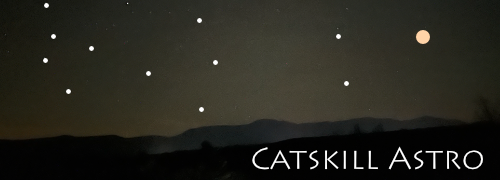Messier Objects
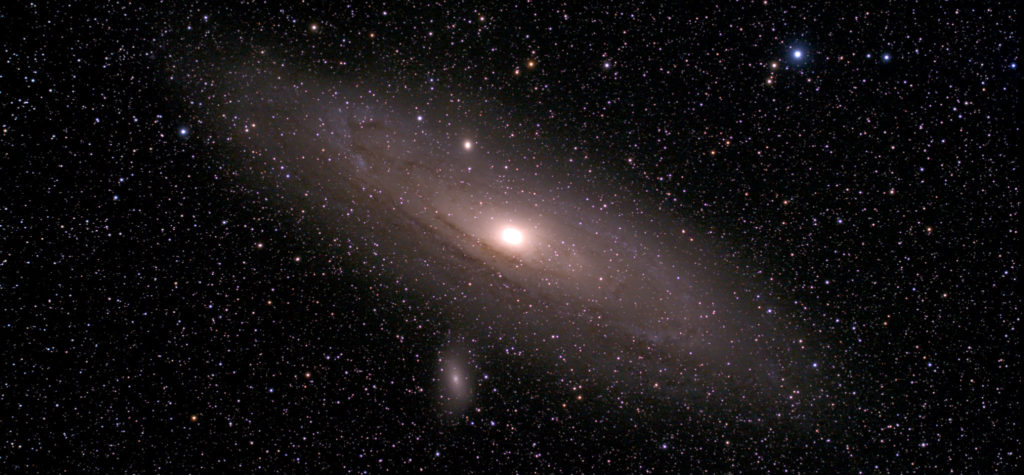
Page 8 of 11
Messier observations 71-80 of 110 total to date.
| Catalog # | Thumbnail | Title/link | Description |
|---|---|---|---|
| M71 | 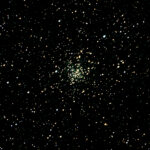 |
M71 / Angelfish Cluster | Discovered by Méchain and reported on October 4, 1780 after confirmation by Messier: "Nebula discovered by M. Méchain on June 28, 1780, between the stars Gamma and Delta Sagittae. On October 4 following, M. Messier looked for it: its light is very faint & it contains no star; the least light makes it disappear. It is situated about 4 degrees below [south of] that which M. Messier discovered in Vulpecula. See No. 27. He reported it on the Chart of the Comet of 1779.' (diam 3.5')" <--> This is one of the least dense of the Messier QC and ranked 26 and 27 respectively for brightness and diameter. The Angel Fish illusion is fairly compelling to my eyes: the fish's nose is the triangular grouping of stars at the 7 o'clock position. The tail ends with the four stars in a line at 1 o'clock. In between, the core of the cluster widens to a reasonably convincing body, terminating with caudal and anal fins. Gaps in the core even hint at stripes. Observed on an evening with terrible seeing causing misshapen stars using my 8" EdgeHD, so the tiny scale is not evident compared to the Seestar captures. |
| M72 | 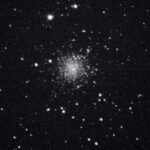 |
M72 / NGC 6981 | Recorded on October 4, 1780: "Nebula seen by M. Méchain in the night of August 29-30, 1780, above the neck of Capricorn. M. Messier looked for it on the 4th and 5th October following: the light is as faint as for the preceding [M71]" <--> With apparent magnitude of only 9.27 and only 6.6 arc-minutes in diameter, this is the dimmest and smallest GC in the catalog. At Dec -12, it's in my southern sky, but rises above the tree line on good nights. I observed this using my EdgeHD, so in comparison to the Seestar, it seems relatively large. |
| M73 |  |
M73 / NGC 6994 | Discovered by Messier (#34) on October 4 & 5, 1780: `Cluster of three or four small stars, which resembles a nebula at first sight, containing a little nebulosity: this cluster is situated on the same parallel as the preceding nebula [M72]..." <--> This is one of the oddest Messier objects in the catalog, even more than M40. Messier categorized it as a "cluster", but Messier's own listing reflects skepticism. John Herschel, the best telescope builder of his era, doubted this was a cluster when he looked at it a year or two later. But such was Messier's rep that he (Herschel) included it in his catalogue, and so it survived into the NGC, and here I am observing and cataloging it on my website. As it turned out, this issue remained open until a 2002 research paper definitively concluded it was an asterism: M. Odenkirchen & C. Soubiran (2002). "NGC 6994: Clearly not a physical stellar ensemble". Astronomy & Astrophysics. 383 (1): 163–170. arXiv:astro-ph/0111601 |
| M74 | 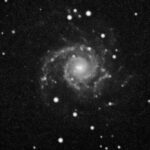 |
M74 / NGC628 | Discovered by Méchain and recorded October 18, 1780: "Nebula without stars, near the star Eta Piscium, seen by M. Méchain at the end of September 1780, & he reports: 'This nebula doesn't contain any stars; it is fairly large, very obscure, and extremely difficult to observe; one can recognize it with more certainty in fine, frosty conditions'. M. Messier looked for it & found it, as M. Méchain describes it..." <--> Not for nothing is this Galaxy nicknamed the "Phantom Galaxy" as it exhibits the lowest surface brightness of any Messier object. For no particularly good reason, it always seems to be in an awkward position when I'm ready to observe it. This observation, perhaps my 3rd or 4th, was enhanced by converting from color and processing the image in monochrome. That said, it's a gorgeous grand-design spiral, large and face on. |
| M75 | 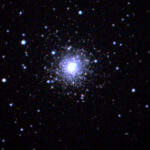 |
M75 / NGC 6864 | Another Méchain discovery, recorded October 18, 1780: `Nebula without star, between Sagittarius & the head of Capricorn; seen by M. Méchain on August 27 & 28, 1780. M. Messier looked for it on the following October 5, & on October 18.... M. Messier saw it on October 5; but the Moon being above the horizon, & it was not until the 18th of the same month that he was able to judge about its form & determine its position.' <--> This is the second dimmest and smallest Mesier GC, after M72. At Dec -21 it is visible from my backyard, so I could view it in the EdgeHD. Herschel described it as a miniature M3, which seems apt. Both are relatively circular GCs |
| M76 | 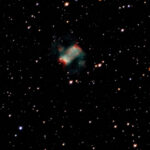 |
M76 / Little Dumbbell Nebula / NGC 650 | Recorded October 21, 1780: "Nebula at the right foot of Andromeda, seen by M. Méchain on September 5, 1780, & he reports: 'This nebula contains no star; it is small and faint' On the following October 21, M. Messier looked for it with his achromatic telescope, & it seemed to him that it was composed of nothing but small stars, containing nebulosity, & that the least light employed to illuminate the micrometer wires causes it disappear" <--> Interesting to compare this object to M57 (Ring Nebula). Assuming their underlying forms are similar, is the difference the angle of view? Instead of sideways, if the dumbbell were pointed directly at us, would they be similar? I suspect so. |
| M77 | 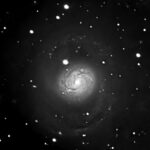 |
Arp 37 / M77 Revisit | This is actually a very challenging observation because the nucleus is so bright, and the outer rings are so dim. I ended up adding a UV/IR cut filter to reduce near infrared light from nucleus, which helped a little. Then post processing to recover the center. MESSIER COMMENTS: Recorded December 17, 1780: "Cluster of small stars, which contains some nebulosity, in Cetus & on the parallel of the star Delta, reported of the third magnitude, & which M. Messier estimated to be hardly of the fifth. M. Méchain saw this cluster on October 29, 1780 in the form of a nebula." Interesting... Messier didn't see the nebula. Just a cluster of stars on top? Was his eyesight starting to fail? |
| M78 | 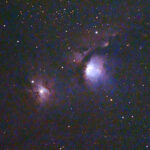 |
M78 / NGC 2068 | Méchain again, December 17, 1780): Cluster of stars, with much nebulosity in Orion & on the same parallel as the star Delta in the belt.... M. Méchain had seen this cluster at the beginning of 1780, & reported: "On the left side of Orion, 2 to 3 minutes in diameter, one can see two fairly bright nuclei, surrounded by nebulosity".' (diam. 3') <--> This is a beautiful, small reflection nebula in Orion, and one of the brightest in the sky. Overshadowed by its gaudier neighbors: this is still a significant star forming region. If this weren't in Orion, it might be more famous... but it's probably Nebula #5 in Orion behind M42/43, Running Man, Horsehead, and Flame, not to mention additional nebulae in Monceros (Rosette, Christmas Tree). Superior in beauty and mystery to the Iris Nebula, but much less known. What is the second bright nucleus in Méchain's description? Two portions of what we now call M78/NGC 2068? Or one of the other nebulae? |
| M79 | 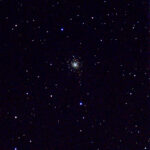 |
M 79 / NGC 1904 | Recorded December 17, 1780: `Nebula without star, situated below Lepus, & on the same parallel as a star of sixth magnitude: seen by M. Méchain on October 26, 1780. M. Messier looked for it on the following December 17: this nebula is beautiful; the center brilliant, the nebulosity a little diffuse." <--> This was an opportunistic capture when I saw that Orion was high in the sky at 4AM and set up the Seestar to capture M70 in Lepus (just below Orion), which had been on my "wish list". A far southerly globular cluster captured at around 20° elevation. Ranking 22 and 23 respectively for brightness and size... it's evident by comparison in the un-cropped Seestar image. The core appears more elongated than most, and is surrounded by a tulip-shaped halo of red(?) giant stars. |
| M80 | 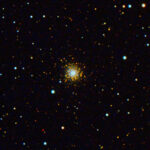 |
M80 / NGC 6093 | Recorded January 4, 1781: "Nebula without star, in Scorpius....: this nebula is round, the center brilliant, & it resembles the nucleus of a small Comet, surrounded with nebulosity. M. Méchain saw it on January 27, 1781.' (diam. 2')" <--> Rank 17 and 22 respectively for magnitude and size. March 2025 capture was in good pre-dawn conditions. This was first light for my new 2600mc-pro camera paired with the Askar V configured at 600mm. The featured image here is heavily cropped. I've also added to the gallery an early observation from May, 2024 using the Seestar. Both images depict an apparently small, round cluster against a star-field mottled with dark nebulae. Located at -20 declination, which puts this quite low on the horizon at 42°N. |
